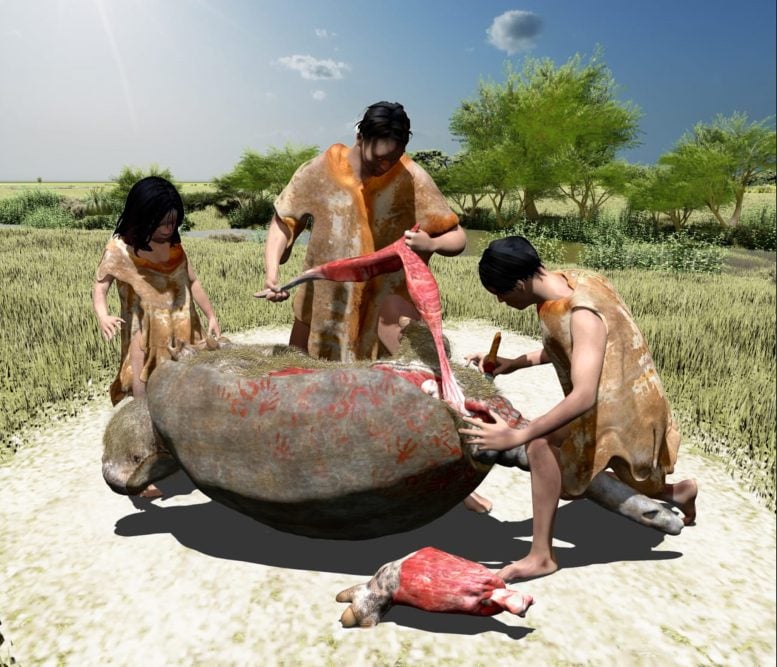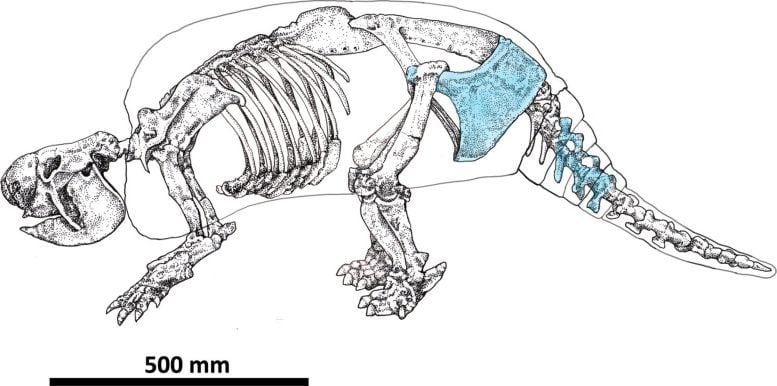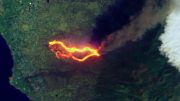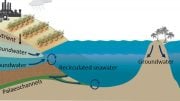
3D rendering of the probable butchery event according to a paleoartistic reconstruction. The illustration was made by modeling three-dimensional meshes, 3D digital scanning, and texturing by projection, based on the proportions of the excavated fossil materials and the results obtained in the study. Credit: Damián Voglino, Museo de Ciencias Naturales A. Scasso (Colegio Don Bosco), San Nicolás de los Arroyos, Provincia de Buenos Aires, CC-BY 4.0
Tool marks might represent some of the earliest known signs of human presence in southern South America.
Recent findings from Argentina indicate human presence and exploitation of large mammals over 20,000 years ago, challenging previous beliefs about when humans first settled in the Americas.
According to a study recently published in the open-access journal PLOS ONE, incisions found on fossils suggest that humans may have utilized large mammals in Argentina over 20,000 years ago. The research, conducted by Mariano Del Papa and colleagues from the National University of La Plata, Argentina, explores this possibility.
The timing of early human occupation of South America is a topic of intense debate, highly relevant to a study of early human dispersal across the Americas and of humans’ potential role in the extinction of large mammals at the end of the Pleistocene Epoch. This discussion is hampered by a general scarcity of direct archaeological evidence of early human presence and human-animal interactions.

Drawing of a Neosclerocalyptus skeleton highlighting cut-marked skeletal elements in light blue found at the CRS-10 specimen. Credit: Del Papa et al., 2024, PLOS ONE, CC-BY 4.0
In this study, researchers present evidence of butchery on Pleistocene mammal fossils from the banks of the Reconquista River, northeast of the Pampean region in Argentina. The fossils are those of a glyptodont, a giant relative of armadillos, named Neosclerocalyptus. Statistical analysis finds that cut marks on parts of the pelvis, tail, and body armor are consistent with known marks made by stone tools, and the placement of these marks is consistent with a butchering sequence targeting areas of dense flesh. Radiocarbon dating indicates these fossils are around 21,000 years old, nearly six thousand years older than other known archaeological evidence in southern South America.
These results fit with other recent findings that indicate early human presence in the Americas over 20,000 years ago. These fossils are also among the oldest evidence of human interaction with large mammals shortly before many of those mammals became extinct. The authors suggest that these findings might be further supported by additional excavation at this site, further analysis of the cut marks, and more extensive radiocarbon dating of the fossils.
Miguel Delgado, the corresponding author, adds: “The study’s evidence puts into question the time frame for the first human peopling of the Americas 16,000 years ago.”
Reference: “Anthropic cut marks in extinct megafauna bones from the Pampean region (Argentina) at the last glacial maximum” by Mariano Del Papa, Martin De Los Reyes, Daniel G. Poiré, Nicolás Rascovan, Guillermo Jofré and Miguel Delgado, 17 July 2024, PLOS ONE.
DOI: 10.1371/journal.pone.0304956
Work leading to this publication was funded by grants from National Natural Science Foundation of China (#31771393), Wenner-Gren Foundation for Anthropological Research (USA) Grant/Award number 9391, Consejo Nacional de Investigaciones Científicas y Técnicas (CONICET), Facultad de Ciencias Naturales y Museo Universidad Nacional de La Plata (FCNyM, UNLP), INCEPTION program (Investissement d’Avenir grant ANR-16-CONV-0005) and ERC-2020-STG – PaleoMetAmerica – 948800.









Be the first to comment on "Challenging Current Timelines: New Fossil Finds Suggest Early Humans in South America Over 20,000 Years Ago"